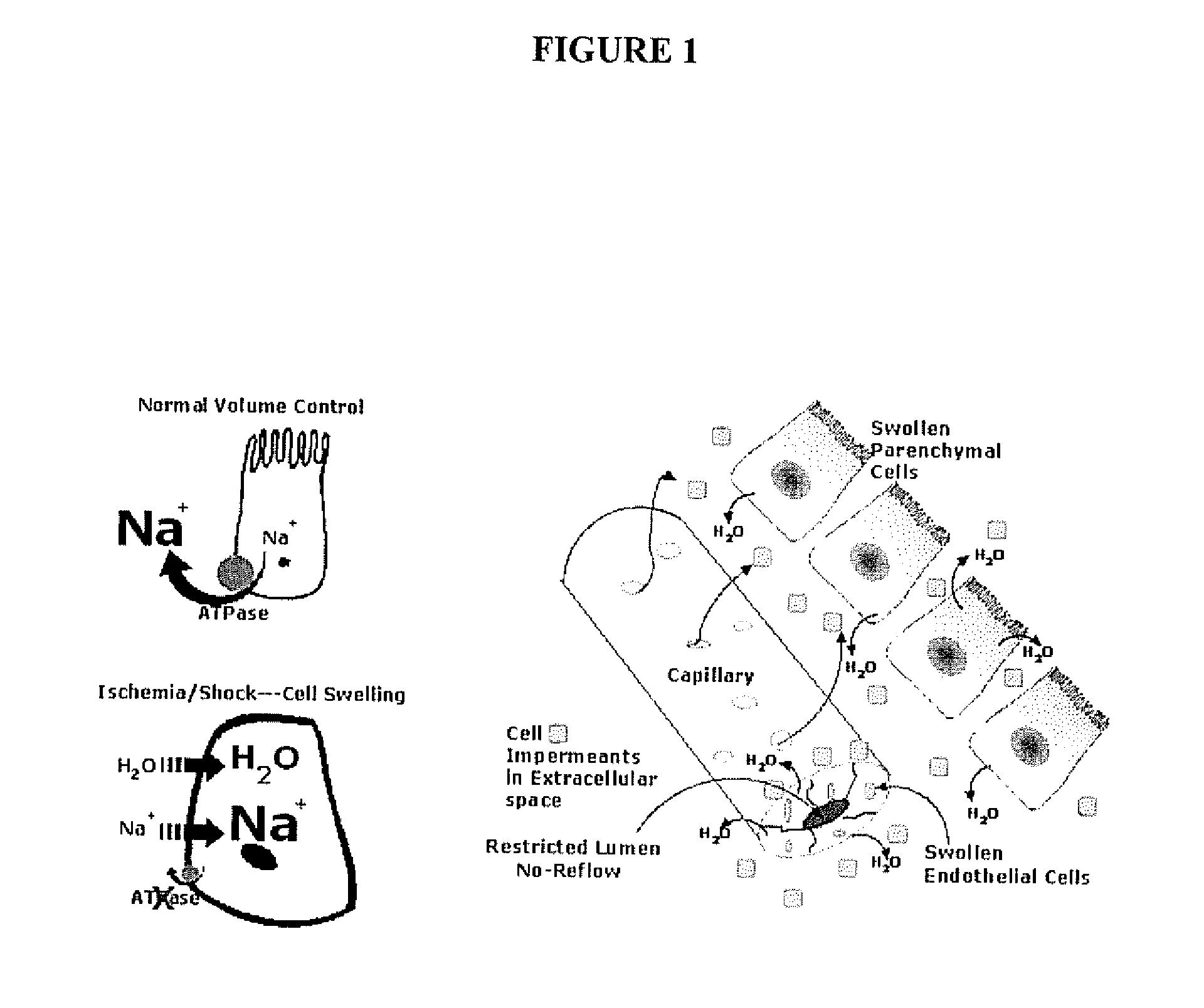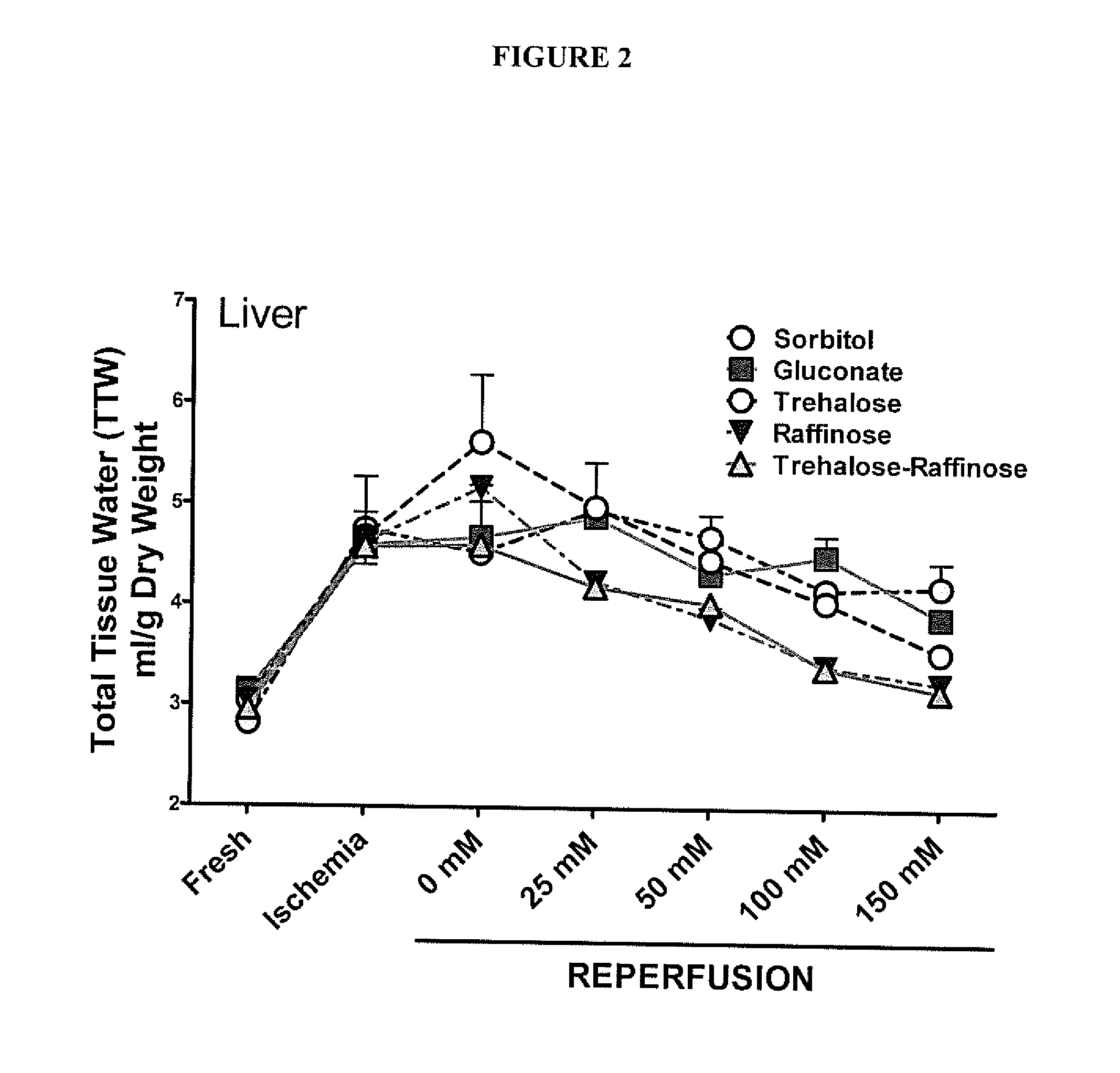Organ protection solution and its method of use
a technology of organ protection and solution, applied in the field of organ protection solution, can solve the problems of many cellular complications and practical limitations, and the resuscitation of hemorrhaged animals and injured patients has been performed with low volume hyperosmotic saline solution, and achieves the effects of preventing or reversing lethal ischemic cell swelling, promoting water movement, and amplifying the effect of impermeable substances
- Summary
- Abstract
- Description
- Claims
- Application Information
AI Technical Summary
Benefits of technology
Problems solved by technology
Method used
Image
Examples
example 1
Exemplary Formulation of Cell-Impermeant-Based Organ Protectant Solution
[0042]Table 1 presents the formulation of one example of a cell impermeant-based organ protectant solution according to the present invention. As discussed herein, the precise formulation of the cell impermeant-based organ protectant solution can vary within the practice of the invention. Specifically, the organ protectant solution should have one or more cell impermeants dissolved or dispersed in a pharmaceutically acceptable vehicle. The cell impermeant(s) will have a charge and / or molecular weight which permits them to freely pass across the capillary endothelium and into the interstitial space of a subject, but they are too large and / or charged to cross the cell plasma membrane such that they preferentially load into the extracellular fluid compartment where they can exert osmotic effects on both endothelial cells and parenchymal cells. They are given in amounts to increase the theoretical extracellular flui...
example 2
Exemplary Method of Administration of the Cell Impermeant-Based Organ Protectant Solutions
[0045]The general rule of thumb should be to start administration of the organ protection solutions as quickly as possible after the start of the ischemic event (e.g., hemorrhage due to trauma, cardiovascular collapse in shock). Give the solutions through an intravenous catheter like any I.V. fluid. For administration during shock, these solutions can be part of the resuscitation fluids. The solutions can be stored in convenient bags typically used I.V. fluid, such as Viaflex, for storage, transportation, and use. Typical administered volumes may be in the range of, for example, 100-2000 ml, 100-1000 ml, 100-500 ml or 100-250 ml per patient, depending on the body mass and condition of the patient and the formulation of the solution. They also may be administered by constant infusion in the intensive care unit (ICU) during recovery from surgery and resuscitation. Alternatively, small amounts, su...
example 3
Determination of Optimal Impermeant Molecules in an Organ Preservation Model
[0047]A series of experiments were performed to explore the optimal impermeant effect of a family of likely useful impermeants. The variables are molecular species of impermeant, concentration (in the extracellular space), and time of administration. For these experiments, the impermeants used included specific anions and small saccharides such as sorbitol, gluconate, trehalose, lactobionate, maltitol, raffinose, and combinations of the same. These agents were dissolved in water of buffer solution such phosphate buffered saline and used in an in vitro tissue culture study.
[0048]FIG. 2 illustrates the effect of various impermeants on cell swelling of liver slices. The outcome variable was cell swelling of liver tissue slices exposed to periods of warm ischemia and reperfusion to mimic the conditions that a DCD donor liver would encounter in order to determine which solutions would minimize in vivo cell swelli...
PUM
| Property | Measurement | Unit |
|---|---|---|
| molecular weight | aaaaa | aaaaa |
| volume | aaaaa | aaaaa |
| volume | aaaaa | aaaaa |
Abstract
Description
Claims
Application Information
 Login to View More
Login to View More - R&D
- Intellectual Property
- Life Sciences
- Materials
- Tech Scout
- Unparalleled Data Quality
- Higher Quality Content
- 60% Fewer Hallucinations
Browse by: Latest US Patents, China's latest patents, Technical Efficacy Thesaurus, Application Domain, Technology Topic, Popular Technical Reports.
© 2025 PatSnap. All rights reserved.Legal|Privacy policy|Modern Slavery Act Transparency Statement|Sitemap|About US| Contact US: help@patsnap.com



